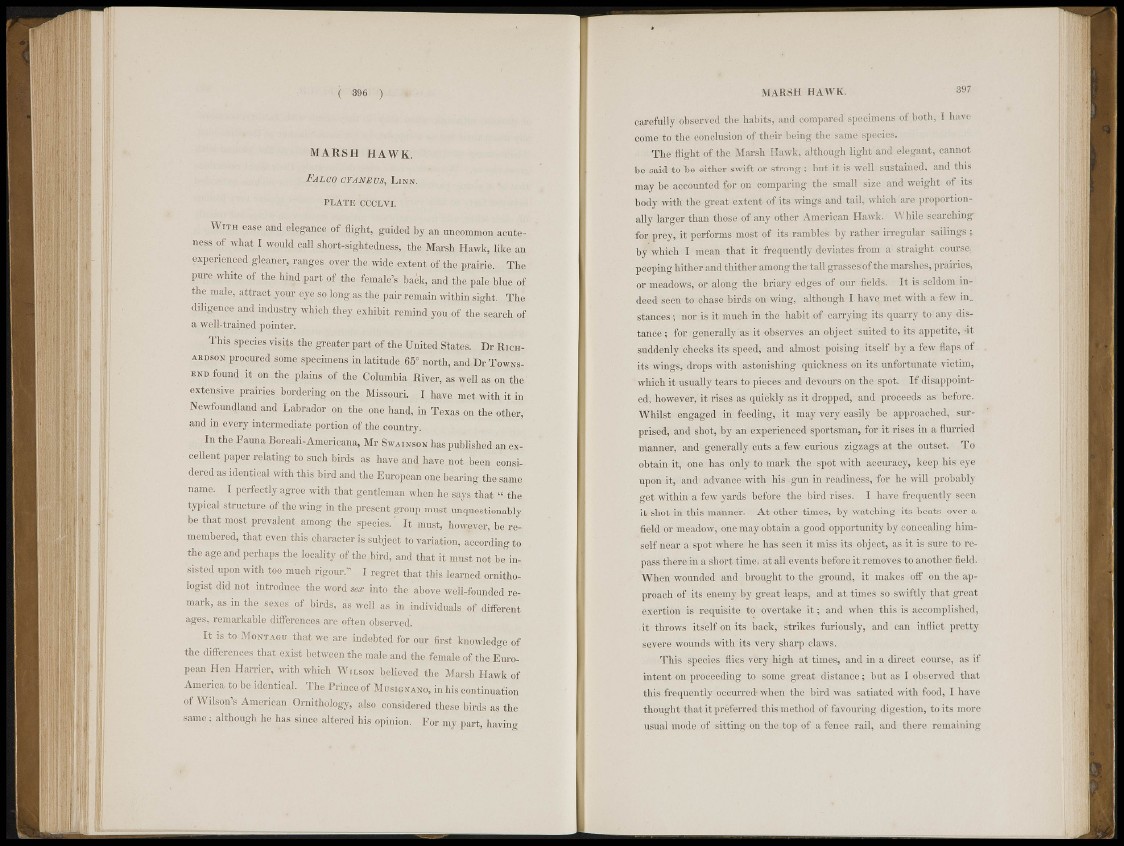
( ' 39« Xij)
MARSH IIMVK.
I'Al.CO CYAXEVS, 7.ISS.
With ease and elegance of flight, guided by an uncommon, ao^te,
ness of what I would sl^.H-sigUtodjiess;, the Marsh Hawk, like an
experienced gleaner, ranges over the wide extent of the prairie The
pure white of the hind part of the female's baik, and the pale blue of
the male, attract your eye so long as the pair remain within sighl. 'Chi
diligence and industry which they exhibit remind you of the search of
a weJLtrained poj i t t t^t .
This spocicsvisj^i; the g reaterpai^f th<ij:iiit«cl.8ta$fcs. »rjiicii-
AKDSON p r o v e d son^ specimens ^'latitude 65° north, and Dr Tot^SW
found it on the plains of the Columbia Hiver, a* woO as *n the
Mtonsh^prairifs bordering ^ the Missoms. ¡1 have met with it m
Newfoundland and Labrador on the one hand, in Texas on the other,
and in every intermediate portion of t.l><> country.
In the^Pauna Bpr^i-Americana, Mr^^i s son.has published-®! ex-
• cellent paper relating to such birds as haye and hare mot been consi,
dered as identical with this bird and the European one bearing the samp
w e . I perfectly agree with that gentleman wiien he says that « the
typical structure ,,f the «ina- in the present group mast unquestionably
be that most prevalent among the species,' It must, however, be re-(
numbered, that even this character is subject to variation, according to
the age and perhaps the locality of the^bird, and that it must not be ins
i s t e < 1 nP°n with too much rigour.™ I regret that this learned ornithologist
did not introduce the word sem into the ahoye well-founded remart,
as in the sexes of birds, as well as in individuals of different
ages, remarkable differences are, often observed;.
I t is to Montagu that we are indebted for our first knowledge of
the differences that exist between the male and the. female of the Eiu-opean
HeiL Harrier, with which Wilson believed the Marsh Hawk of
America to be identical. The Prince of Musionano, in his continuation
of Wilson's American Ornithology, also considered these birds as the
s a m " ; al^otlgh he has since altered his opinion. For my part, having
MARSH HAWK. 397
Carefully observed the habits, and compared' specimens of;both, I have
come to the Conclusion of their being the same species.
The flight ©f the Marsh Hawk, although light'and elegant, cannot
be said tolse either swift or strong ; but it is well sustained, and this
may be accounted for on comparing the small size • and weight of its
body! with" the trfnoat extent of its wings ami tail, which are proportionally
larger than those of any other American Hawk. While! searching'
foMJruy, it perfume must'of its rambles bv rather irregular sailings. ;
bv which I mean, that it frequently deviates from a straight course,
peeping hither and thither among the" tall gi-asses of the marshes, prairies,
or meadows, or along the briary edges'of our fields. It is seldom indeed
seen to cha.se birds oh wing, although I. have .met with a few instances
; nor is it much in the habit of - carrying its quarry to any distance
; for, generally as it observes an object suited to its appetite, »it
suddenly chocks its spend, and almost poising itself by a few flaps of
its Wings,, drops with astonishing quickness o:i its unfortunate victim,
which it usually tears to pieces and devours on tho spot. If disappointed^
however,'it rises: as quickly as it dropped, and proceeds as before.
Whilst engaged in feeding, it may very easily be approached, surprised,
and shot, by an experience;^ sportsman, for i t rises in a flurried
manner, and 'generally cuts a;fe\v curious zigzags at the outset. To
obtain it, one has only to mark the spot with accuracy, keep his eye
upon it, and advance with his gun in readiness,!'for he will probably
get within a row yards before the bird rises. I have frequently seen
it shot in this manner., At other times, by watching its beats over a
field or meadow, one may obtain a good opportunity by concealing himself
near1 a spot where he ha« seen it miss its: object, as it is sure to repass
there in-a short time, at all; events before it removes to another field.
When wounded and brought to tho ground, it makes off on the approach
of its enemy by great leaps', and at times so swiftly that great
exertion; is requisite to overtake it; -and when this is accomplished,
, it throws itself on its: basis, Strikes furiously, and can inflict pretty
severe wounds with its very sharp claws.
This species flies very high at times, and in a direct course, as if
intent on proceeding to some; great distance; but as I observed that
this frequently occurred when the bird was satiated with food, I have
thought that, it preferred this method of favouring digestion, to its more
usual mode of sitting on the; top of a fence rail, and there remaining